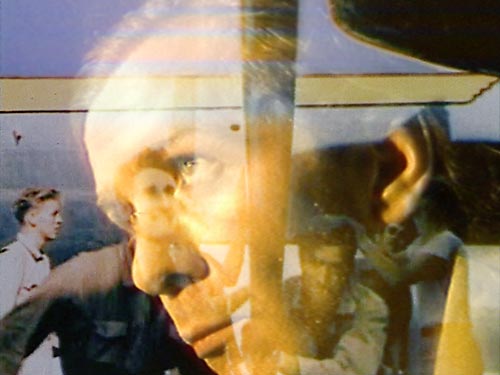Das Filmforum der HBK präsentiert im Sommersemester 2019:
Montag | 27.05.19 | 19:00 h
Klassiker reloaded: 1960er bis 80er-Jahre (Struktureller Film)
Der strukturelle Film ist charakterisiert durch die Kombination von metrischer Konzeption der Filmkader und der Unberechenbarkeit der Wirkungen, die sich aus dem Material der bewegten Bilder und ihrer flüchtigen Abfolge ergeben. So zeigt bspw. 'Castro Street' streng komponierte Bildfolgen entlang der Straße, die dem Film den Namen gibt und erschafft zugleich eine poetisch inspirierte Industrielandschaft. 'T,O,U,C,H,I,N,G' wiederum kombiniert zwei destruktive Portrait-Standbilder mit Positiv-, Negativ-, Flicker- und Farbeffekten in präziser Montage zur endlosen Wiederholung von „Destroy“ auf der Tonspur. Das Programm präsentiert klassische Beispiele des strukturellen Films bis zu dessen Endphase in den frühen 1980er-Jahren. (HK)

Filmprogramm (71 min):
Bruce Baillie – Castro Street
10 min | 1966 | DVD (16mm) | col | sound | OV (nodialog) | US
Paul Sharits – Piece Mandala End War
5 min | 1966 | internet (16mm) | col | silent | OV (nodialog) | US
Paul Sharits – T,O,U,C,H,I,N,G
12 min | 1968 | 16mm | col | sound | OV (nodialog) | US
Tony Conrad & Beverly Conrad – Straight and Narrow
10 min | 1970 | 16mm | bw | sound | OVen | US
Klaus vom Bruch – Das Propellerband
30:15 min | 1979 | digifile (remastered Umatic) | col | sound (mono) | DE
Hannelore Kober & Jonnie Döbele – Anneliese (Liebesfilm in Rot, Grün, Schwarz und Weiß)
4 min | 1980 | internet (16mm) | col | sound | DE/US
Bruce Baillie – Castro Street
10 min | 1966 | DVD (16mm) | col | sound | OV (nodialog) | US
I was so struck by the beauty of Baillie's Castro Street (1966) the first time that I saw it, that I immediately wanted to see it again. The contrasting images (steel/flowers) and sounds, (metal grinding/piano tinkling) are stunning. Shot at the Standard Oil Refinery in Richmond, California the film is full of textured images of trains, metal and machinery. Mixed in are shots of sky and vibrant flowers. One particular scene focuses on the trains which are now moving at a faster pace and opens to a field of stunningly beautiful purple violets set in a field into which another train enters the frame from the right. Baillie's use of negative black and white images in combination with vibrant color images and subtly textured images is magnificent. At times things seems to be sliding over each other, and the viewer is treated to a visual collage of color and form. Baillie describes the contrast in images as being shot in "masculine" and "feminine", and goes on to explain this in an interview with Scott MacDonald for A Critical Cinema 2, "I wanted to visualize that ancient, universal fact of opposites that are one, both in conflict and harmony---opposing each other and abiding together." From the beginning to the end I found myself waiting eagerly for the next image to appear. The inclusion of a popular soft rock melody was a lovely surprise and again contrasted with the sounds of the engines, whistles, and machinery.
This is a stunning film Baillie describes in a note as "The Coming of Consciousness." -- Donna Albano, 2001
http://www.ubu.com/film/baillie_castro.html
Klaus vom Bruch – Das Propellerband
30:15 min | 1979 | digifile (remastered Umatic) | col | sound (mono) | DE
(Start der Enola Gay, Saipan 1945 // Von diesem Flughafen aus startete Colonel Paul Tibbets am 6. August 1945 mit der Enola Gay, einen B-29-Bomber, mit dem er über Hiroshima (Japan) die erste Atombombe in Kriegszeiten abwarf.)
In dem Video aus der Serie: »Warum wir Männer die Technik so lieben« setzt vom Bruch erstmals den Wiederholungsschnitt als zentrales Prinzip ein: [...] Zwischen dieses farbige Dokumentarmaterial aus dem 2. Weltkrieg ist kurz, blitzartig, das Gesicht des Künsters geschnitten. Durch die Länge des Videos wird nicht nur die Geduld der Betrachter auf die Probe gestellt, sondern auch die Bildwirkung verändert. Aus einem einmaligen Ereignis wird so eine sisyphushafte Schlüsselszene für das Verhältnis von Körper und Maschine sowie ihrer Verbindung zum Kriegsapparat. Die Selbstporträts des Künstlers als »junger Held« sind im Rahmen einer Live-Aktion eingeschnitten worden.
In einer Verbindung von Installation, Videoband und Performance hat Klaus vom Bruch 1979 im Künstlerhaus Stuttgart "Das Propellerband" geschnitten: Sein von einer Videokamera aufgenommenes Gesicht wird live in das laufende Band mit den sich wiederholenden Dokumentarsequenzen der Soldaten eingeschnitten. Die Aktion dauert 45 Minuten, davon werden 30 Minuten für das endgültige Tape verwendet.
http://www.medienkunstnetz.de/werke/propellerband/
[ Abbildung oben: aus dem Video 'Das Propellerband' (1979) von Klaus vom Bruch ]